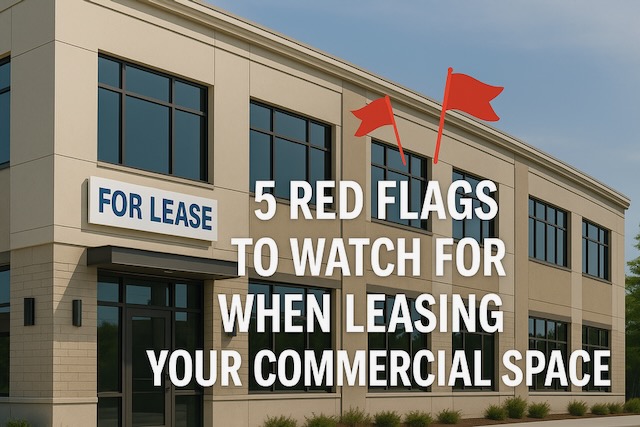5 Red Flags to Watch for When Leasing Your Commercial Space | Commercial Property Management — Auburn, Grass Valley & Nevada City, CA
5 Red Flags to Watch for When Leasing Your Commercial Space
Leasing commercial space can be one of the most important decisions you make as an owner. The right lease protects your income, preserves your asset, and keeps operations smooth. The wrong lease — or a tenant relationship built on unclear expectations — can cost you thousands and lead to long-term headaches. Below are five common red flags and practical steps you can take to protect your investment. If you prefer hands-off protection, our commercial property management services in Auburn, Grass Valley and Nevada City, CA are built to spot and fix these issues early.
Red Flag #1 — Vague or One-Sided Lease Language
Why it matters: A lease that leaves responsibilities, timelines, or penalties unclear gives tenants and owners too much room for disagreement. Vague language creates enforcement problems and often shifts expense burdens to the landlord later.
- What to look for: Missing definitions for "operating expenses," unclear CAM (Common Area Maintenance) formulas, vague repair timelines, or ambiguous renewal terms.
- Tip: Always insist on clearly defined terms and examples for variable charges. Request a sample invoice or CAM reconciliation template as an attachment to the lease.
Example: A lease says the tenant will pay "their share of maintenance" but does not define the method for calculating that share. That leaves room for disputes when a large roof repair bill appears.
How we help: We review proposed lease language, recommend landlord-friendly clauses, and use our commercial leasing experience to write leases that protect all parties. We also build standardized addendums for Auburn / Grass Valley / Nevada City markets so you don’t have to reinvent the wheel for every tenant.
Red Flag #2 — Unclear Maintenance and Repair Responsibilities
Why it matters: Repairs are expensive. If the lease doesn’t clearly allocate routine maintenance versus capital repairs, you could be stuck covering major costs you didn’t expect.
- What to look for: No distinction between "tenant maintenance" and "landlord capital repairs," or missing language about who pays for structural vs. non-structural work.
- Tip: Specify who is responsible for HVAC, roof, plumbing, and structural issues. Include thresholds for cost or age that define capital work.
Example: A tenant’s HVAC breaks and the lease language is unclear — does the owner pay for a full system replacement or only the repair?
How we help: We negotiate clear maintenance roles in leases, set allowable expense caps (if applicable), and suggest preventive maintenance programs to implement so systems last longer and surprises are minimized.
Red Flag #3 — Hidden Costs: CAM, Property Taxes, and Insurance Gaps
Why it matters: Variable charges can erode net operating income when they're not spelled out. Hidden or poorly defined CAM charges, ambiguous tax pass-throughs, or insufficient insurance requirements are common revenue leaks.
- What to look for: Open-ended CAM language, no reconciliation process, vague insurance coverage limits, or failure to require proof of tenant insurance.
- Tip: Require annual CAM reconciliations, cap certain pass-throughs if reasonable, and require certificate of insurance with landlord as additional insured.
Example: The lease allows "all operating costs" to be passed through without a reconciliation schedule, and the tenant later contests charges for capital roof repairs that were included in CAM.
How we help: We implement transparent CAM accounting, handle reconciliations, verify insurance certificates, and advise on reasonable caps for pass-through expenses. Our experience in Auburn and Grass Valley ensures CAM items are market-appropriate for local property types.
Red Flag #4 — Zoning, Use Restrictions, and Compliance Issues
Why it matters: A wrong or restricted use can force a tenant to stop operations, reduce income, or require expensive retrofits. Zoning or permit issues can also create legal exposure for owners.
- What to look for: Leases that permit broad uses without confirming local zoning, no requirement for tenant to maintain necessary permits or licensing, or failure to confirm ADA/compliance responsibilities.
- Tip: Verify permitted uses with the city and write lease language conditioning occupancy on necessary permits and licenses.
Example: A tenant signs a lease to run a commercial bakery but discovers local code or building constraints make that use difficult or illegal without costly upgrades.
How we help: We require that all perspective applicants run use and zoning checks before lease signing, require proof of permits, and coordinate with local contractors and city planning departments in Auburn, Grass Valley and Nevada City to reduce surprises.
Red Flag #5 — Weak Financial Vetting or Insurance Requirements
Why it matters: A good-looking tenant on paper can still be a cash-flow risk if credit, revenue, or insurance aren’t verified. Tenant defaults, insufficient insurance, or undercapitalized businesses can leave owners holding unpaid rent and legal bills.
- What to look for: No credit check, no financial statements required for larger spaces, or weak default remedies and security deposit language.
- Tip: Require credit checks, personal guarantees as appropriate, proof of business income and performance history, and insurance limits that protect your liability and property interests.
Example: A tenant defaults after six months; the lease required only a small security deposit and no personal guarantee, making eviction lengthy and costly.
How we help: We perform thorough tenant screening (credit, background, and financials), structure security deposits and guarantees, and enforce insurance requirements so you have both prevention and recourse.
Practical Next Steps — Protect Yourself Before You Sign
- Have a local commercial property manager review proposed lease terms before signing.
- Run zoning and permit checks with city planning in Auburn/Grass Valley/Nevada City.
- Insist on annual CAM reconciliations and clear maintenance roles.
- Verify tenant insurance and require landlord to be additional insured.
- Use market-standard addendums tailored to Northern California commercial leases.
Quick reminder: The best way to avoid costly mistakes is to catch them early — during lease negotiation. We specialize in protecting landlords from these five red flags and more.
Why Choose Local Commercial Property Management?
Working with a property manager who knows Auburn, Grass Valley and Nevada City means leases and processes are tailored to local market norms, city codes, and typical tenant profiles. We bring:
- Local market knowledge — so CAM items, rent comps and permitted uses are accurate.
- Established vendor relationships — for fast, cost-effective repairs and compliance upgrades.
- Templates and processes — landlord-favoring leases and standardized addendums that reduce negotiation time.
- Hands-off management — tenant screening, rent collection, CAM reconciliations, and legal coordination handled for you.
If you want to stop guessing and start protecting your asset, contact us.


